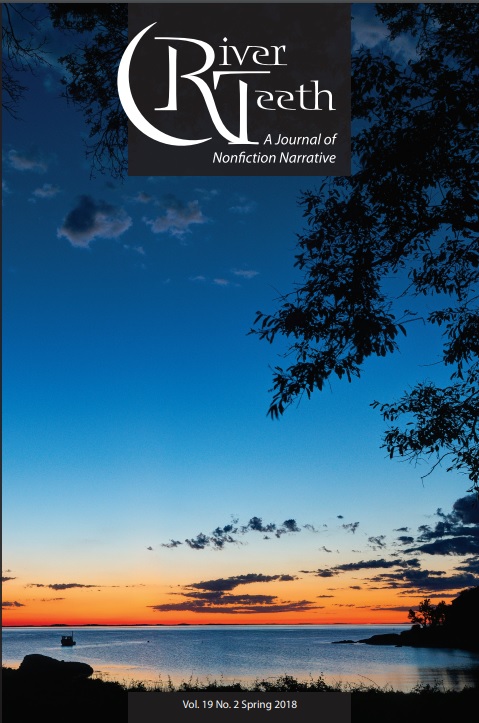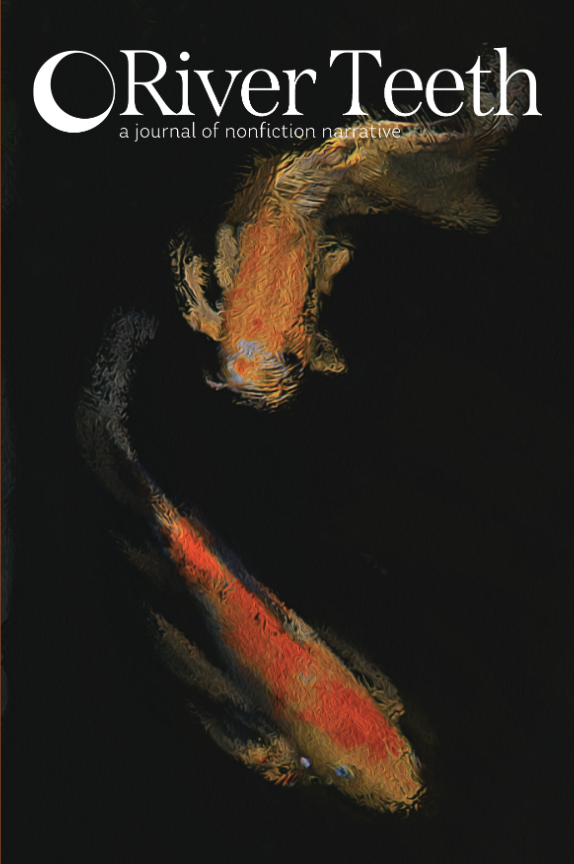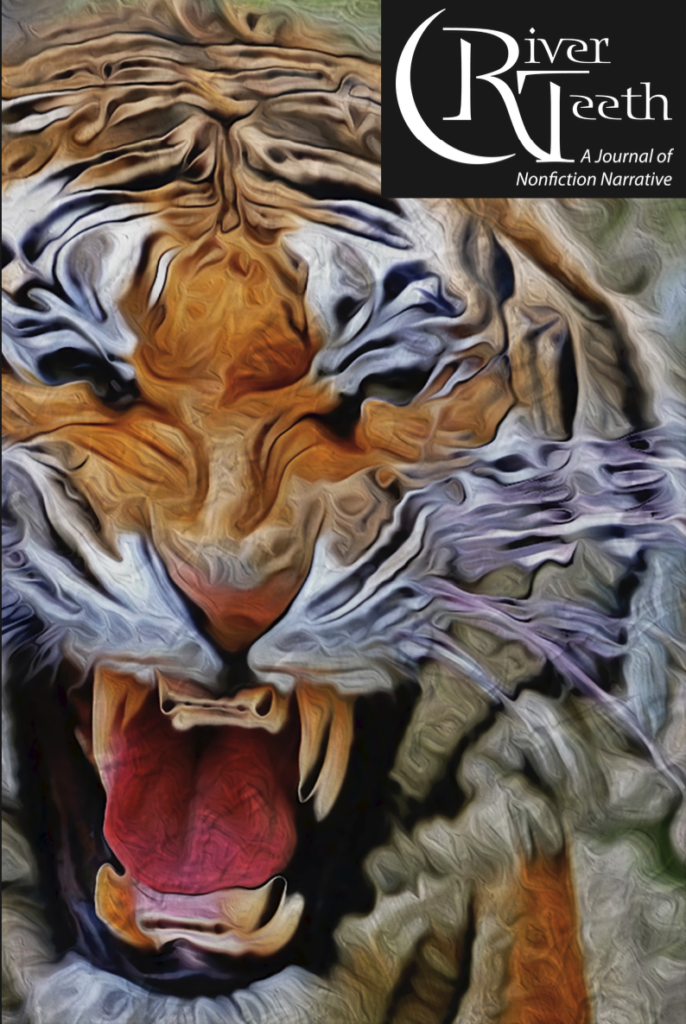By Dan Lehman
Spread the word and shop for the birthday gifts! River Teeth: A Journal of Nonfiction Narrative is a teenager no longer! Our nineteenth volume closes with the issue you hold or are reading onscreen. And so we stride into our twentieth year by publishing what we believe to be the best and most consistently interesting journal dedicated to nonfiction: essays, memoir, literary reporting, craft and critical monographs, and all those delicious nonfictional variations too interesting to pin down.
Of course we feel that way; otherwise, why do this?
Anniversaries are a useful time to look back, to test oneself against the ideals and promises with which a love affair begins. Some historical context here: Early in River Teeth‘s debut year, President Clinton (no, that one!), having been impeached a month earlier, was acquitted in a U.S. Senate trial gaveled by U.S. Chief Justice William Rehnquist. John F. Kennedy Jr. died in a plane crash off Martha’s Vineyard; shots rang out at Columbine High School and robbed a generation of its innocence. Buffy the Vampire Slayer was television’s hottest show; SpongeBob SquarePants was all set to debut. At the movies, American Beauty vied with The Sixth Sense for audience and critical buzz. Pamela Anderson divorced Tommy Lee that year; most of us would have to use a dial-up modem to surf the sordid details. But better act quickly and start that surf dialing before Y2K crashes us all!
Meanwhile two professors at a small university in Ohio, both ex-journalists and devotees of fine writing, had an idea. What if there were a journal focused exclusively on nonfiction, especially a journal that published the best of literary journalism as well as first-person essays and memoir? We looked around and could not find the exact one we loved, so why not start one ourselves? We had no one to tell us no, and so we did it. Somehow we convinced writers like Nancy Mairs, Sydney Lea, Kim Barnes, Philip Gerard, and others to join our inaugural editorial board. David James Duncan lent us our name and wrote a bang-up inaugural essay, explaining the “River Teeth” conceit, which we still feature at the head of our website. We
published three Pulitzer Prize winning writers in that very first issue and matched John Reed’s peerless reporting from Serbia in 1915 with Philip Smucker’s vivid, groundbreaking dispatches from then-contemporary Kosovo.
“Here the river widened out and poured thunderously over an immense dam; and looking down, we could see the clear water running above a mass of sodden cloth and bodies bloated gray… . In the light of blue electric arcs, long chains of Austrian prisoners were unloading flour to feed the desolate country, until the harvests could be sewn and gathered. And as we waited on the platform, I thought with wonder of these Serbians, their origin and their destiny.” – John Reed, 1915
* * *
“As we descended into a pine forest, a cluster of someone hundred homes became visible in the valley. On a ridge, overlooking a hamlet, we squatted with a pair of tiny yellow binoculars looking six hundred feet down into the village for anything that moved. A few cows meandered in the main street. Then, suddenly, a patrol of some eight Yugoslav soldiers, special forces in black, emerged from behind a house. One soldier backed along a brick wall and turned in a 360-degree circle as he moved. ” – Philip Smucker, 1999.
Here’s the thing: Twenty years ago we knew we were swimming against a pretty strong critical tide. In the postmodern academy, the rush to expose false binaries was all the rage, and one of those false binaries was fiction and nonfiction. All knowledge is representation, the thinking went; all is culturally and ideologically produced, no fact can be solid, and the very idea of truth is a conceit. While we would never argue that the notion of truth was fixed and innocent, we nonetheless wanted to insist that the distinction between truth and invention mattered. What made nonfiction interesting was the very difficulty in pinning it down. What counted was the ever-complex relationship between the character on the page and the character in life, the event as represented and the event as remembered by others. We weren’t after innocence; we were after implication.
And so we wrote in our inaugural editorial twenty years ago: [T]he writer of a story that claims to be true—particularly a story so good you live with its characters, confront their problems as they confront or evade them, and can’t put the story down until you discover what happens to them—gains the enormous power and sanctity that a reader might assign to an actual life. A family gathers near a hospital emergency room, as it does in one of this volume’s pieces, and the glue that holds both them and the reader to the scene is the value of the waning life before them. In fiction, when characters die and live, characters breathe or stop breathing; in nonfiction, when characters die and live, people breathe or stop breathing.”
In these two decades we have said much the same thing in different words, again and again. Truth matters—never more than now. It is seldom easy to pin down facts and represent them, but that’s the point. And what began as a largely academic assault on the concepts of truth and factual reference has metastasized in our current national discourse.
Daily we hear the label “fake news” applied to solidly documented reporting that simply exposes or inconveniences the name caller.
Implication as slur.
As Thomas Larson writes in the River Teeth you hold, the very issue in which we bid farewell to our feisty teen decade: “Nonfiction writers have been stubbornly informational for centuries…. It’s a spurious argument that nonfictionists misled themselves by loading their work with ‘the meaninglessness’ of veracity. The point is ridiculous…. What essayist do you know who claims it’s OK to craft a coming-of-age story in which the author labels her mother an undercover cop, instead of (the truth) President of the Police Review Board, because the former serves the author’s aesthetic purpose as a literary writer?”
And so, we promise to remain feisty, outspoken, committed to the truth, no matter how complicated and difficult, ready and eager to publish all those writers who accept that challenge and who write with craft and beauty, who pull us in, who change us, who enlighten us, who make us weep and squirm.
And, damn it, we are just getting started!
—DWL












